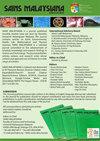来自欺骗岛的南极孢子形成微生物抑制多种细菌菌株的生长
IF 0.7
4区 综合性期刊
Q3 MULTIDISCIPLINARY SCIENCES
引用次数: 0
摘要
南极微生物已经进化并适应了在恶劣的极地环境中生存的独特策略。除了能够适应营养成分含量低、极度干燥和寒冷的极地环境外,南极细菌还采用了一种特殊的策略,即产生抗菌化合物,以消灭同一生态位中的竞争对手,从而使它们比其他微生物更具竞争优势。相比之下,孢子形成微生物是否具有类似的抗菌特性作为其生存策略之一尚不清楚,尤其是那些来自南极西部火山岛欺骗岛的微生物。因此,本研究旨在分离和鉴定南极欺骗岛的孢子形成微生物,并确定哪些微生物具有抑制其他微生物的能力。利用各种生长培养基分离微生物,并根据微生物的随机扩增多态 DNA(RAPD)指纹将其分群。共分离出 90 株菌株,以 60% 的相似度分成 30 个群组。对每个群中的代表性菌株进行了抗菌活性测定,以检测其对 13 种革兰氏阳性和革兰氏阴性试验细菌(包括人类病原体)的抗菌活性。25 株菌株至少能抑制一种试验细菌。对抑制活性最强的四株菌株 A60、Im31、Im32 和 Im33 进行了 16S 或 18S rDNA 测序和分析,以确定它们的身份。上述微生物之所以能在恶劣的环境中繁衍生息,并与激烈的竞争者争夺稀缺的营养物质,很可能是因为它们能够产生抗菌化合物,以杀死对手。本文章由计算机程序翻译,如有差异,请以英文原文为准。
Antarctic Spore-Forming Microorganisms from Deception Island Inhibit the Growth of Various Bacterial Strains
Antarctic microbes have evolved and adapted unique strategies to survive in the harsh polar environment. Apart from the ability to adapt to the low nutrient soil content and extremely dry and cold polar environment, a particular strategy used by Antarctic bacteria is the production of antimicrobial compounds that can eliminate rivals in the same niche, giving them a competitive edge over other microbes. In contrast, it is unclear whether spore-forming microbes possess similar antimicrobial properties as one of their survival strategies, especially those from the Antarctic volcanic Deception island in the West Antarctic. Hence, this study aims to isolate and characterize the spore-forming microbes in Deception Island, Antarctica, as well as to identify the ones that are equipped with the ability to inhibit other microorganisms. Microbes were isolated using various growth media and were segregated into clusters based on their random amplified polymorphic DNA (RAPD) fingerprints. A total of 90 strains were isolated and clustered into 30 groups at a similarity of 60%. Representative strains from each cluster were assayed for antimicrobial activities against 13 Gram-positive and Gram-negative test bacteria comprising human pathogens. Twenty-five strains exhibited the ability to inhibit at least one test bacterium. The four strains, A60, Im31, Im32 and Im33 that showed the strongest inhibitory activities were subjected to 16S or 18S rDNA sequencing and analysis to identify them. They were identified as Pseudogymnoascus, Bacillus, Leohumicola, and Talaromyces spp. The ability of the aforementioned microbes to thrive in harsh environments and compete with fierce competitors for scarce nutrients is probably due to their ability to produce antimicrobial compounds that target and kill their rivals.
求助全文
通过发布文献求助,成功后即可免费获取论文全文。
去求助
来源期刊

Sains Malaysiana
MULTIDISCIPLINARY SCIENCES-
CiteScore
1.60
自引率
12.50%
发文量
196
审稿时长
3-6 weeks
期刊介绍:
Sains Malaysiana is a refereed journal committed to the advancement of scholarly knowledge and research findings of the several branches of science and technology. It contains articles on Earth Sciences, Health Sciences, Life Sciences, Mathematical Sciences and Physical Sciences. The journal publishes articles, reviews, and research notes whose content and approach are of interest to a wide range of scholars. Sains Malaysiana is published by the UKM Press an its autonomous Editorial Board are drawn from the Faculty of Science and Technology, Universiti Kebangsaan Malaysia. In addition, distinguished scholars from local and foreign universities are appointed to serve as advisory board members and referees.
 求助内容:
求助内容: 应助结果提醒方式:
应助结果提醒方式:


